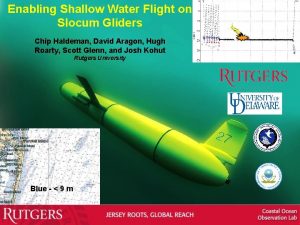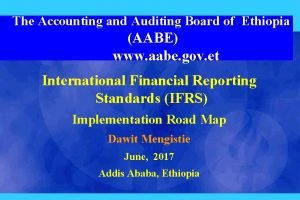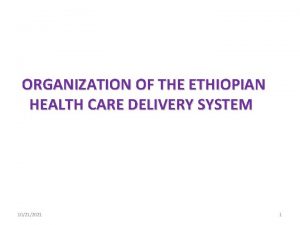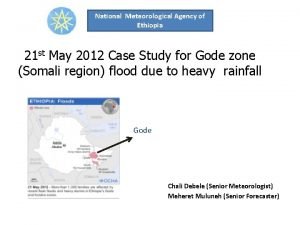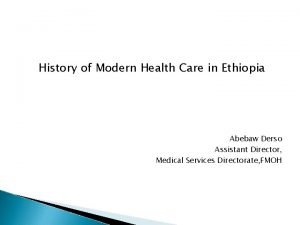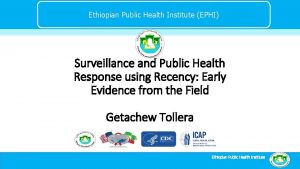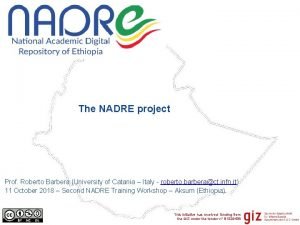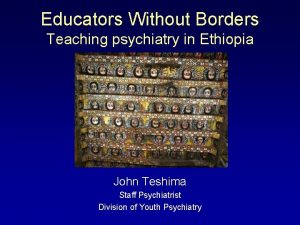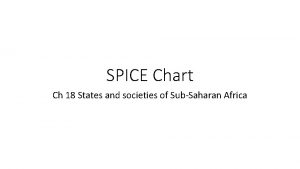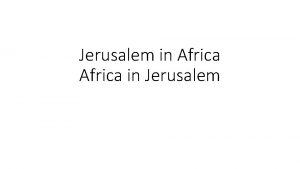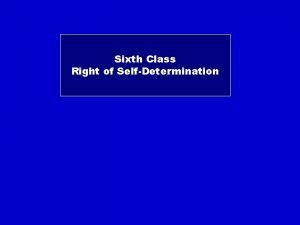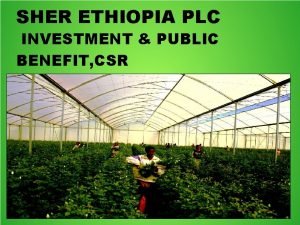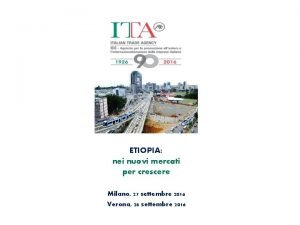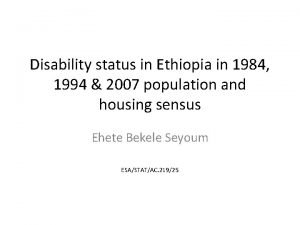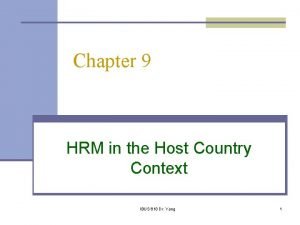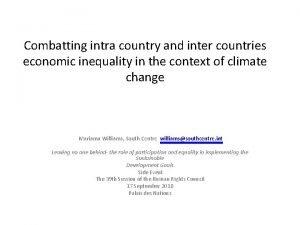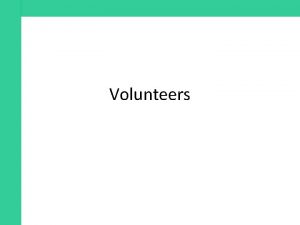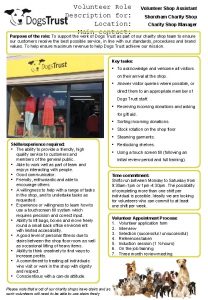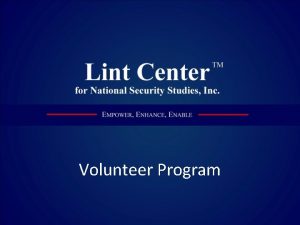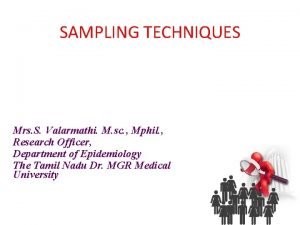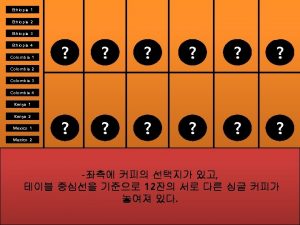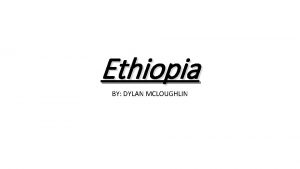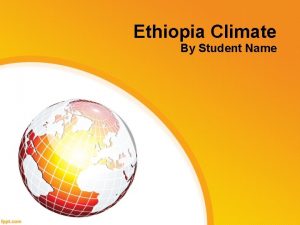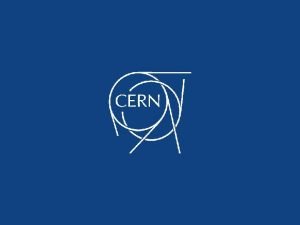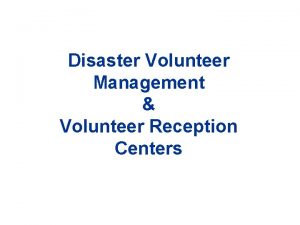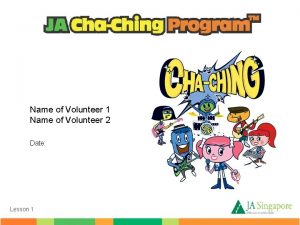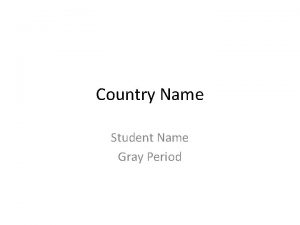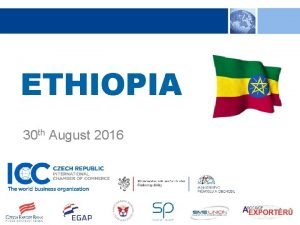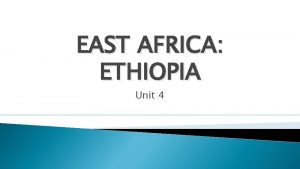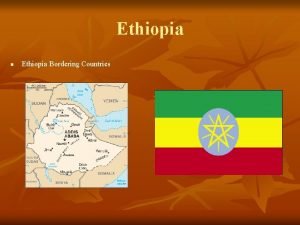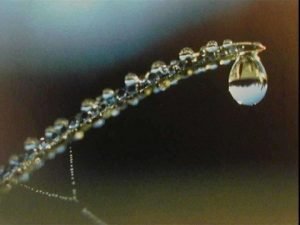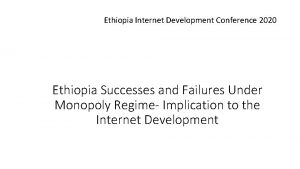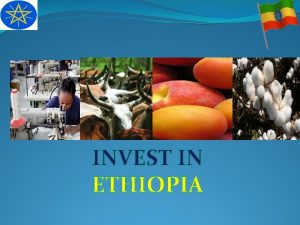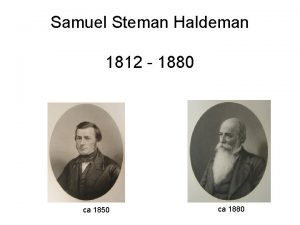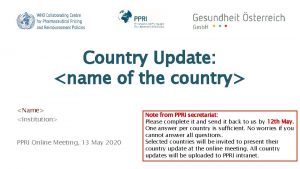Volunteer Name James F Haldeman Country Ethiopia Country



































- Slides: 35

Volunteer Name: James F. Haldeman Country: Ethiopia Country project: Grain Crops Production & Sector Support (ET 44) Host: Sodo Catholic Secretariat Venue: Bedessa and Duguno Fungo Woredas Audience: Kebele Adminstrators, Development Agents and Farmers Number of people : 724 Date: March 25 – April 15, 2016

1. Assignment Objectives as in SOW Equip Smallholder Farmers and Other stakeholders with Innovative Agronomic Practices and technologies for increased yields and quality of Maize and Haricot Bean 1. Select 2 Woredas – Select 20 Kebeles for training 2. Train Development Agents – “Train the Trainer” 3. Train Farmers – Reach as many farmers as possible in 10 training days

1. Assignment Objectives as in SOW (continued) 4. Teach improved Fertilizer Application methods for Maize a. DAP 100 kg/ha @ Planting b. Urea 150 -250 kg/ha @ First Weeding c. Measurement of Fertilizer and Application practice 5. Teach improved Planting methods a. Seed and Row Spacing 6. Teach Seed Spacing for Haricot Bean and use of Rhyzobium bacteria Inoculation for Legumes 7. Establish Demonstrations to show benefit of improved seeds, planting and fertilizer methods (Not done)

Traditional Method: Plowing

Traditional Method: Fertilizer Measurement with Bottle Cap

Traditional Method: Fertilizer and Seed placement Seeds placed too close to concentrated fertilizer (ammonia burn)

Potential Inaccuracy of Bottle-Cap method to Measure Fertilizer • Intended DAP rate: 100 kg/ha • Some farmers apply about… ~ 38 heaping caps-full (~5/8 Cup) per 15 meter row • Correct rate is ½ Cup per 15 meter row • Some farmers apply 25% too much. Some may apply too little

Kebele Administrator making Introduction

The Instructors James Sintayehu

The Lesson Plan

The Tools 15 m Seed Spacing Line, marked every 25 cm

Sintayehu giving instruction

Compare and Contrast new methods to Traditional ways

Marking Rows with Seed Placement Line

Making Furrows for DAP Fertilizer and Seeds 1. DAP applied in-furrow, 10 cm deep 2. Seeds placed 25 cm apart in-furrow 5 cm deep, 5 cm beside fertilizer

Measuring Fertilizer

Fertilizer Application Rate, 15 m Row Length, 75 cm between rows 25 cm between seeds (0. 00113 ha) DAP (18 -46 -0) @ Planting Urea (46 -0 -0) @ First Weeding 100 kg/ha (Min) = 18 -46 -0/ha • 113 grams/15 meter row 150 kg/ha = 69 -0 -0/ha • 170 grams/15 meter row ~ 11/8 (1. 125) Cup ~ ½ (0. 5) Cup Maize, knee-high DAP applied in-furrow 10 cm deep and 5 cm beside seed furrow 200 kg/ha = 92 -0 -0/ha • 227 grams/15 meter row ~ 1 ½ (1. 5) Cup Urea applied in band between rows and worked lightly into soil 250 kg/ha = 115 -0 -0/ha • 283 grams/15 meter row ~ 1 7/8 (1. 875) Cup

Measured Fertilizer applied infurrow with “highland” bottle

Seed Spacing in-furrow 25 cm apart, 5 cm deep 5 cm away from fertilizer

Development Agent reviewing fertilizer and planting instructions

Farmers Discussing and Demonstrating their Knowledge

2. Achievement of the assignment objectives : Trainee Summary Bedessa Woreda 1. 2. 3. 4. 5. 6. 7. 8. 9. Belbo Badessa Ambe Badessa Tora Offere Mayo Offere Anaka Shashar Gerrar Ambe Cheffese Tora Sadoba Adecha Duguna Fungo Woreda 66 35 25 45 44 80 33 70 51 1. 2. 3. 4. 5. 6. 7. Aresewoyde Edo Sore Edo Bolosa Anka Domot Anka Duguna Fungo Bijo Fungo Damot 30 27 30 80 37 28 43

Trainee Summary • • • Kebele Administrators: Development Agents: Farmers: Female: Male: Total Trained: (continued) 28 28 668 151 (21%) 573 (79%) 724

3. Recommendations to the host with regards to the assignment • Use Trainee lists for follow-up in Kebeles • Retrain DAs – Review planting and fertilizer application methods. – Assure understanding: How to plant, measure and apply fertilizer accurately – Encourage DAs to assemble teaching tools – Encourage them to establish Demonstrations with increasing fertilizer rates…”Seeing is Believing” – Compare and Contrast

3. Recommendations to the host with regards to the assignment (continued) • Follow up to assess adoption and effectiveness of training and new methods • Coach farmers if needed. • Before first weeding • follow up to review training and assure that Urea will be applied correctly with recommended rate • Encourage weeding as needed • Remove weeds when small – avoid competition for moisture and nutrients • “One year of weeds… 10 Years of Weeding”

3. Recommendations to the host with regards to the assignment (continued) • Encourage use of Soil Testing • p. H very important…Application of Lime or Wood Ash if p. H is low (ideal 6. 5 to 7. 0) – Near neutral p. H Improves Phosphorus and other nutrient availability – Improves activity of Rhyzobium bacteria inoculation for legumes • Encourage DAs to use Leadership Skills • Become the respected Expert • Retrain Farmers… “Hear 3 times to Understand” and again, “Seeing is Believing”

4. Anticipated Impact • Proper placement of DAP and Urea – Improve accuracy of the application rate/ha – Prevent fertilizer “burn” of seedling roots – Improve survival of seedlings and vigor – Promote consistent “stands” – Promote “uniform” emergence and growth – Improve availability of nutrients – Reduce time and labor requirement vs. bottle cap method – Increase Yields

4. Anticipated Impact (continued) • Proper Planting Depth and Seed Spacing – Assure a consistent (equal) growing area and available resources per plant – Reduce intra-plant competition for light, soil moisture and nutrients – Improve seedling survival – Reduce number of unproductive ‘Stunted” plants – Increase Yields

5. Recommended future volunteer Assistance • “Build” on new Fertilizer and Planting Methods • Assess impact of training – Identify Farmers who adopted new methods – Obtain “feedback” from farmers. Address questions and concerns – Measure yields – quintals/ha compared to traditional methods – Conduct Post-Harvest training meetings to review new methods, present and discuss results

5. Recommended future volunteer Assistance (continued) • Establish Demonstrations: – 1 per Woreda per year ? • Must be Well planned and Executed – Demonstrate performance of new Hybrids – Demonstrate use for Lime to improve p. H – Demonstrate increased N and P rates with DAP(to 400 kg/ha) and Urea (to 300 kg/ha) – Follow and support through growing season – Harvest, Record, Report, Train with results – Excellent training opportunity

5. Recommended future volunteer Assistance (continued) • Suggested Demonstration options: – See Wolayta Zone Seed and Fertilizer Demo spreadsheet

6. Recommendations to other non-host stakeholders • Woreda/Kebele Leaders – Establish on-going “Learning Center” Farm • secure access for future – Demonstrate improved Seeds, Lime, Fertilizer rates, simple tools, post harvest storage – Promote DA Leadership and Teaching skills, Promote DA Learning – Promote Farmer Learning

Action plan for host recommendations Recommendation 1. Follow-Up in kebeles 2. Retrain DAs and Farmers: 3. Encourage DAs 4. End of season assessment 5. Plan Follow-up CRS Volunteer Assignment s Specific Action Assess DA and Farmer understanding and adoption of fertilizer and planting methods Address questions, retrain correct application of DAP Encourage DA personal responsibility to Learn and Train Farmers Assess effectiveness of new methods. Measure yields. Record learnings. Do Post Harvest Training Next CRS Volunteers t o reinforce and build on training, Train on storage and loss prevention Establish Demonstrations Responsible person By when SCS Sintayehu Through growing Season SCS Sintayehu Before First Weeding SCS, Sintayehu Woreda, Kebele, Administrators On-going SCS, Woreda, Kebele, Administrators Pre/Post Harvest CRS, SCS, Woreda, Kebele , Administrators Pre/Post Harvest Fall 2016, Spring 2017

7. How can CRS improve future volunteer experience • Work with Host: – Assure room availability • Hotel in Sodo did not honor reservation commitment – Needed to find other accommodations after 4 nights • Sodo Catholic Secretariat provided excellent accommodations and meals – SCS recommended for future assignments in Sodo – Internet “dongle” essential at SCS…no Wi. Fi » “dongle” failed a few days before completion – Assure vehicle and driver availability • Lost time due to unavailability of car or driver or administrative delays…about 2 days

Thank You!
 Haldeman
Haldeman Name three line segments
Name three line segments Scsi unit fbi
Scsi unit fbi James clayton lawson
James clayton lawson Aabe ethiopia website
Aabe ethiopia website Six tier health system in ethiopia
Six tier health system in ethiopia National meteorological agency of ethiopia
National meteorological agency of ethiopia Modern medicine in ethiopia
Modern medicine in ethiopia Ephi ethiopia
Ephi ethiopia Iia ethiopia
Iia ethiopia Prof barbera
Prof barbera Health sector transformation plan ii ethiopia
Health sector transformation plan ii ethiopia Family medicine in ethiopia
Family medicine in ethiopia Psychiatry in ethiopia
Psychiatry in ethiopia Mali spice chart
Mali spice chart Ethiopia street jerusalem
Ethiopia street jerusalem Esap ethiopia
Esap ethiopia Ethiopia water
Ethiopia water Challenges of interest free banking in ethiopia
Challenges of interest free banking in ethiopia Ethiopia constitution
Ethiopia constitution Sher ethiopia plc
Sher ethiopia plc Invest in ethiopia
Invest in ethiopia Band aid 2010
Band aid 2010 Mga bansa sa unang digmaang pandaigdig
Mga bansa sa unang digmaang pandaigdig Ethiopia religion
Ethiopia religion History of disability in ethiopia
History of disability in ethiopia 1935 italy invades ethiopia reaction
1935 italy invades ethiopia reaction Host country and home country
Host country and home country Intra country vs inter country
Intra country vs inter country Volunteer work meaning
Volunteer work meaning Dogs trust volunteers
Dogs trust volunteers Dogs trust volunteer
Dogs trust volunteer Volunteer recruitment survey questions
Volunteer recruitment survey questions Volunteer onboarding flow chart
Volunteer onboarding flow chart Unesco hr manual
Unesco hr manual Merits and demerits of cluster sampling
Merits and demerits of cluster sampling
